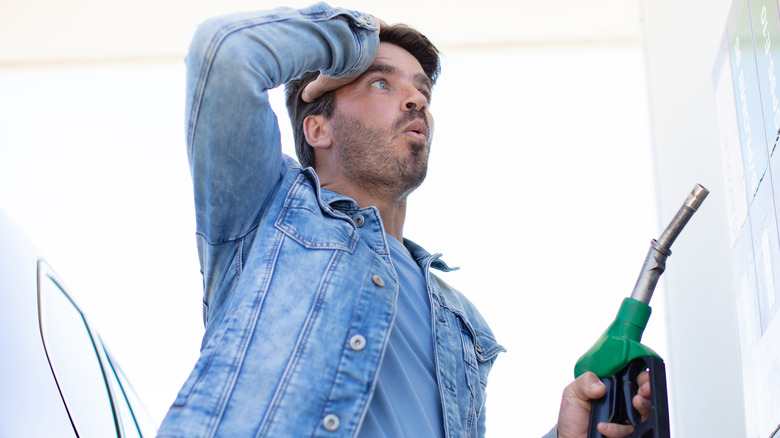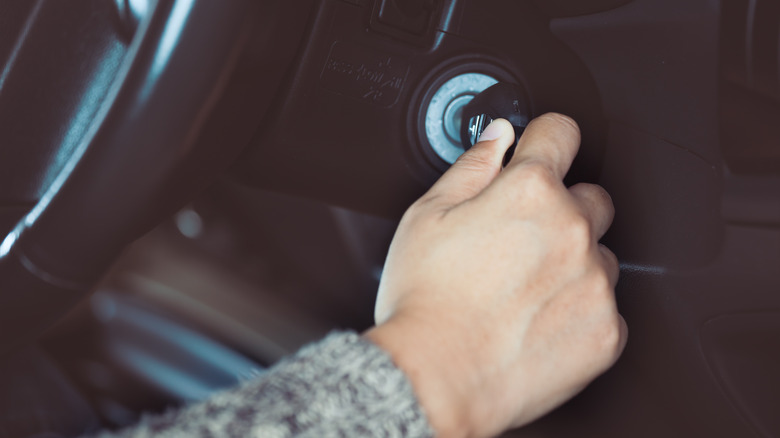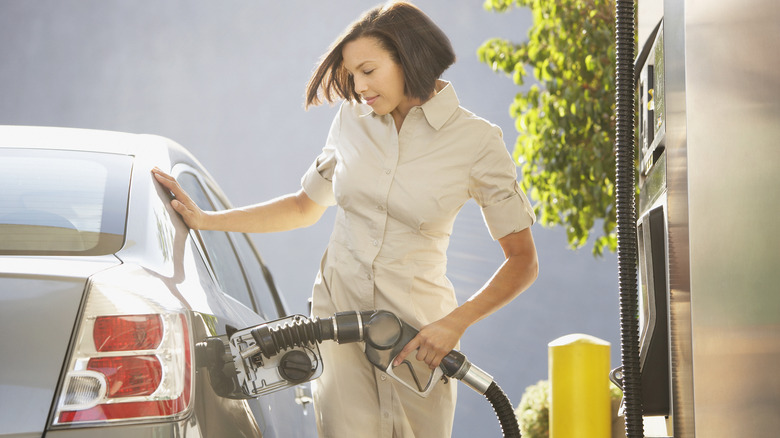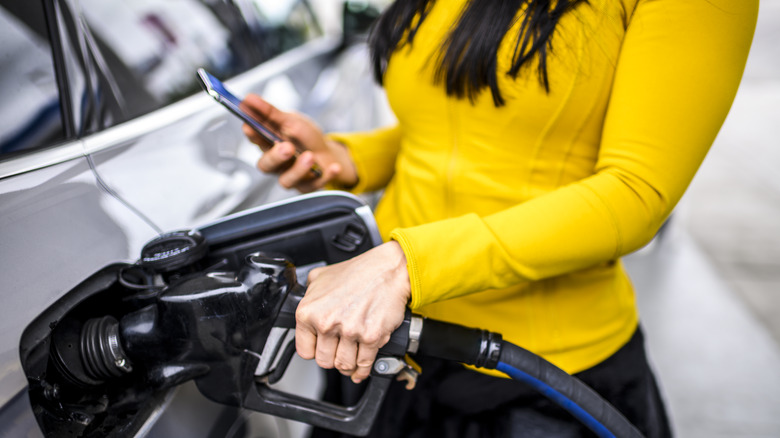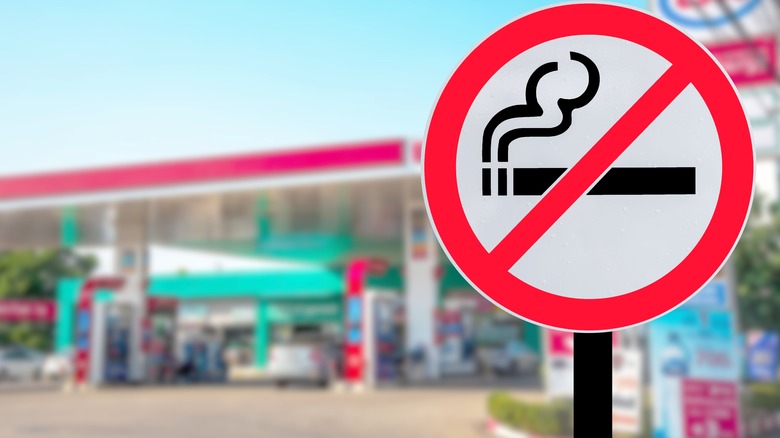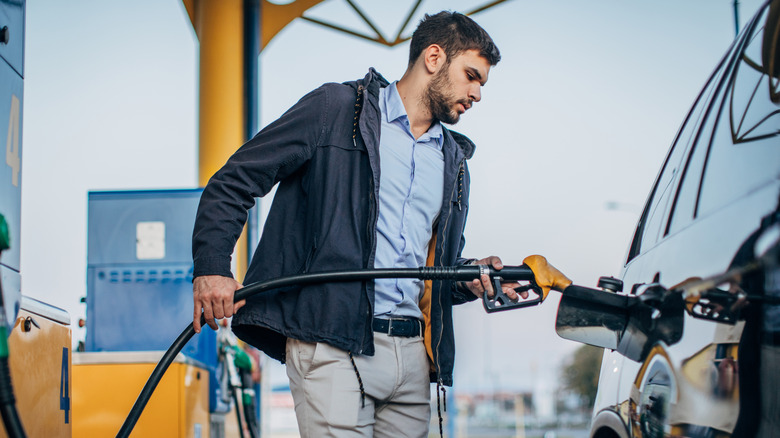5 Important Things You Should Be Doing When You Pump Gas
When a person goes to fuel their automobile, many motorists are probably guilty of not taking it very seriously. They may regard the mundane assignment as another thoughtless task, making up their lackluster routine next to similar ordeals like brushing their teeth or taking out the garbage. While there is no denying these dreary dilemmas offer little to no excitement, there are plenty of disadvantages to negating the responsibility of refueling the ride, as well as several less-than-ideal potential outcomes for not practicing proper pump etiquette. Surprisingly enough, there are even a few advantages to putting an accurate amount of effort into properly filling up at the pump.
It's important to remember that, at its core, pumping gas is about more than just replenishing the fuel supply. Ensuring the gas tank is on the right side, choosing the correct octane gas, and not losing the gas cap aren't the only challenges drivers will face. Despite it being pretty straightforward, it's not uncommon for consumers to neglect some other responsibilities that should be applied when picking up petrol. The pivotal act of refueling a person's main transportation source should be conducted as a step-by-step process that includes a few easy-to-remember precautionary measures that can significantly reduce risks and even increase vehicle efficiency. Whether you're a seasoned driver or a novice at the pump, here are several important things car owners should be doing while filling up the tank that will transform this everyday chore into a safer and more cost-effective experience.
Make sure the engine isn't running
One of the first things people should do is ensure the engine is off before pumping gas. Not only should the vehicle refrain from running, but any 12-volt power sources, such as cigarette lighters or phone charging devices, should also be disengaged. The reason for the necessary shutdown protocols at the petrol station is that keeping a car running during refueling increases the fire risk, as the engine's heat and static electricity can easily ignite gas fumes. This dangerous mix creates an environment where a simple spark could lead to a serious blaze. Despite these types of unwanted incidents being uncommon, a report from J.D. Power indicates that local fire departments responded to an estimated 4,150 service station or gas station property fires annually between 2014 and 2018. These incidents resulted in three civilian fire fatalities, 43 civilian fire injuries, and approximately $30 million in direct property damage each year during this period.
Even if leaving the car on may seem like an ideal solution — especially for those wanting to maintain a cool atmosphere with a flowing air conditioner on a hot day or keep the interior from feeling like an igloo on a cold winter morning — ensuring the engine is not running while refueling isn't a guideline motorists should ignore. Not only is it a requirement of the International Fire Code, but it is arguably one of the easiest measures that can be taken to prevent the simple task of filling up the tank from burning up into a hot mess.
Remain outside the vehicle
Another good tip is to resist the urge to get back into the automobile while fueling. Staying out of the rain or trying to escape the cold during a snowy day can make finding sanctuary in the passenger compartment an enticing option when refueling one's ride. Still, unfortunately, it is a pretty bad idea. A study by the Petroleum Equipment Institute (PEI) analyzed 176 gas station fires where no open flames, running motors, or electrical continuity problems were evident. Shockingly, nearly 50% of these cases occurred when the driver returned to their automobile during refueling and subsequently touched the nozzle after leaving the vehicle. "You get that static discharge from your body to that metallic nozzle, and when that occurs, there's potential for a spark to happen, " Scott Boorse, PEI director of technical programs and industry affairs, explained to Reader's Digest. "That spark is enough to ignite any of the vapors that are around the tip of the nozzle."
To help automobile owners mitigate this risk, the American Petroleum Institute (API) recommends a simple yet effective precautionary measure that involves the motorist touching a metal part of the car with their bare hand after exiting, such as a door or any other metal surface that is not in proximity to the fuel filler. The action helps disperse any static charge, lowering the chances of a spark and ensuring a safer refueling experience. While it may initially seem excessive, remaining outside the vehicle while pumping gas is a critical safety practice with plenty of evidence to back it up.
Prioritize a phone-free approach to pumping gas
While it may seem like the perfect opportunity to pull out the phone, motorists should avoid such behavior while refueling a vehicle. Even though there could potentially be a fire hazard at the pump, experts claim the chances of someone's mobile device causing an explosive reaction when filling the tank aren't very high. "The risk is very, very low," National Fire Protection Association staff liaison Michael Marando said when talking to USA Today. Still, he also made it clear that such a thing wasn't impossible. "For me to say there's no risk, I can't really do that because there could be some really, really one-in-a-several billion chance that it could possibly happen. There's just too many factors that have to line up that it's extraordinarily rare."
It's probably a good call to leave the phone in the automobile when pumping gas to lower the chance of problems arising from consumers being distracted by a screen. "It's really to make sure that the people at the gas station are paying attention to refueling instead of talking on the cell phone," Mando explained. People are less likely to skip a safety measure or inadvertently cause a crisis if they are laser-focused on the task at hand. A no-phone fuel policy is a good way to prevent any unwanted mishaps, even ones that are equal parts embarrassing and dangerous. "Retailers say that virtually all instances of someone driving off with the nozzle attached to the cars is because the driver was distracted by being on the phone," National Association of Convenience and Fuel Retailing spokesperson Jeff Lenard said, according to Reader's Digest.
Avoid the temptation to smoke or vape
Most drivers out there are very aware that gasoline is quite flammable and that anything involving fire of any kind should not be done near a gas pump. So, it would be wise for motorists to postpone lighting up a cigarette while filling up the tank because not being able to wait until the petrol station is in the rearview mirror to do so could lead to disastrous consequences. When it comes to fire safety, Georgia Fire Prevention Chief Brenda Thomas claims smoking at the gas pump is one of the biggest risks, and any tiny chunk of ash could ignite the gasoline vapors in the air. She isn't the only advocate to make it known how imperative it is that everyone realizes that filling up the tank should absolutely be a smoke-free activity. The American Petroleum Institute clearly states, "Do not smoke, light matches, or lighters while refueling at the pump or when using gasoline anywhere else."
While it's clear tobacco cigarettes are no good when gassing up, many may expect that vaping would be a safe alternative, but they would be incorrect. Using vape pens or e-cigarettes would also not be a good idea as they could ignite the gas vapors, causing a fire by emitting additional heat or static electricity. Such a catastrophe can be completely avoided if vehicle owners focus solely on following all the steps to pump gas safely instead of trying to sneak in a smoke break.
Maintain the correct fuel level
There is one more preventative protocol to remember next time people stop at the gas station. When the pump shuts off, it's meant to be a clear indicator to motorists that the tank is filled, and adding any additional fuel is simply unnecessary. Despite being given a clear sign that the task has been completed successfully, some can't help but take things too far. Many people tend to top off their tank, and even though it doesn't need it, they continue to squeeze as much gas as possible out of the nozzle, not realizing the damage they are actually doing. "By topping your fuel tank off, it can either overwhelm your evaporative system and break something or cause a hazardous leak by the excess pressure in the system," Ed Nemphos, owner of Brentwood Automotive in Baltimore, said, according to the Detroit Free Press. In addition, Caruso's Auto Repair Owner, Joel Caruso, is also an advocate against topping off, saying, "When we overfill the tank, it sends all of the excessive fuel to the evaporation/charcoal canister and kills the life of that canister." The repairs could cost a consumer up to $1,500.
It isn't just the vehicle or a person's bank account at risk. Topping off the tank can cause gasoline to spill onto a person, which isn't known to react well when it comes in contact with the skin. If an individual is lucky enough not to get any on them, the chances are it ended up on the ground and is now taking its toll on the environment, proving that when it comes to pumping gas, enough is really enough.
